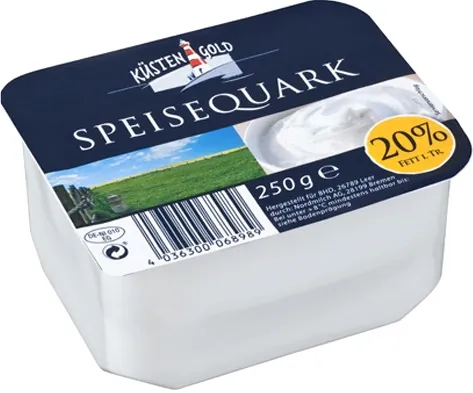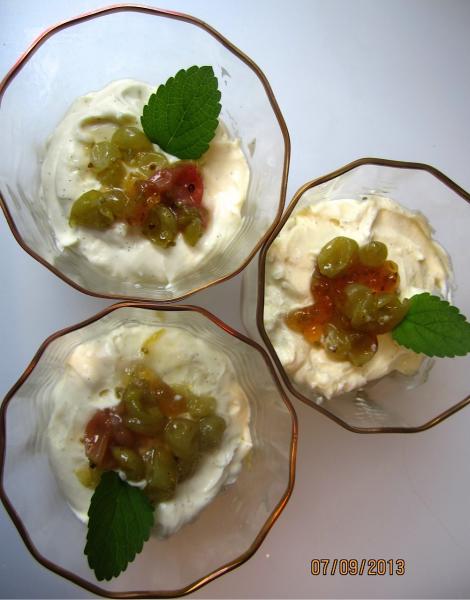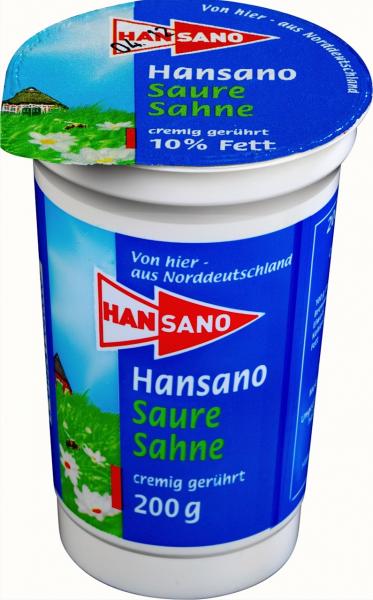
Finding American equivalents or substitutes for foreign ingredients can be quite challenging. Whether you move to Europe, or like me, come to the US from Germany, you naively expect common products like flour or milk to be the same.
Sure, my American whole wheat breads turned out just fine, I was happy that they rose so nicely. But when I tried baking everyday German rolls, Weizenbrötchen, with all-purpose flour (wasn't that for all purposes, after all?) I was in for a surprise.
From the outside they were the same, but when I cut the rolls, there was no fluffy, soft inside, but a chewy, lean crumb with irregular holes that looked distinctly like Paris, but not like Hamburg or Kiel.

Baking German breads in Maine was a challenge - not all flours are created equal
I had learned a lesson, all-purpose flour is not like all-purpose flour. Everything is bigger in the US, and so is the protein content of the wheat!
So, a while ago, I came up with an EUROPEAN/AMERICAN FLOUR "TRANSLATION", one of the most popular posts on my blog.
This summer I prepared a favorite dessert, St. Colomba Cream, for the first time in Maine, but I didn't quite know what to use instead of the sahnequark (cream quark) the recipe requires.
Well, it has cream in it, I mused, and so has mascarpone. And that's what I took.

St. Colomba Cream - with mascarpone instead of quark?
But instead of creating a smooth, velvety dessert, I ended up with a dense and uber-rich vanilla cream. With 30% more fat than it should have had, the saintly Irish gooseberry dessert weighed down our stomachs like a stone.
Some European dairy products seem to be just the same as their American namesakes. But are they, really?
If you find an interesting recipe in a German, Austrian or Swiss website or blog, don't think Google translate will be any help: Saure Sahne, Sauerrahm, Schmand: all of them are "sour cream" - but no sour cream!

It's "sour cream" - but is it sour cream? No!
The difference is often the fat content, like with saure sahne and sour cream, though in many cases you can exchange a full fat into low-fat dairy to make a leaner version of a recipe, and vice versa. And some European dairy products are more acidic as their US counterparts, like yogurt or buttermilk.
To find American equivalents for some, and workable substitutes for others, check my: CREAM OR SAHNE - DAIRY CONVERSION
- hanseata's Blog
- Log in or register to post comments
Hi Karin,
I love your 'pantry' set up. Everything in its place and ready to go :)
I commend you on sorting out the flour variances. What a challenge! I tried creating AP flour with my whole grains and came up with a 60/40 (Hard ww/soft ww) blend though I don't use it often. Mostly in rolls rather than loaves.
I began making soft cheeses last winter. Just a fun side hobby for people who love soft cheese. I learned a lot about what goes into them and it really is quite simple. THIS site has ingredients and a BOOK that is very straight forward to use for those who don't want too much information. (I fit that description in regards to cheese making :- )
Cultures can be changed and fat content in dairy products you use can all be changed too resulting in consistencies you prefer for what you are making.
Thanks for the post and links to your blog. I loved reading through your findings - as usual!
Take Care,
Janet
Thanks, Janet! Our kitchen is one of our living rooms (the others being the enclosed porch and the garden). I like having a functional set-up and like my tools nice looking, too. The work bench is from Ikea, as are the flour bins, originally meant for toys. Very practical!
So far I grind only my own specialty flours, like barley, farro and kamut, but I will definitely ask you for advice if I try wheat.
I have made something similar to quark, from buttermilk, but though the consistency was right, it was very mild and not tangy. Last week I made Greek yogurt, from a Cook's Illustrated recipe, which turned out very good. Thanks for the links, I will check them out.
Take care,
Karin
Hi Karin,
a more than useful post; especially for those of us who consider ourselves as European.
I wanted to add counsel that, alas, UK "Plain Flour" really isn't the equivalent of All Purpose flour....you've answered the reason why in your post above "Everything is bigger in the US...."
But protein in any UK wheat apart from specific and industrial bread varieties is pretty lamentable, so using Plain flour as a sub for AP is very likely to lead, in many cases, to disappointment. Not a place we want to go to, of course. Blending Plain and Bread flours can give a better approximation of AP. Commercial UK operators can buy a Baker's flour which is ok too.
All good wishes
Andy
Andy, I do appreciate you input! Apart from my own experiences, I pulled all this information from Wikipedia, some bakers' websites, and other sources Google provided me with.
I will change my list according to your suggestion, would 1/2 bread and 1/2 plain flour be the right approximation for AP?
All good wishes,
Karin
Hi Karin,
That's a reasonable approximation, but it is difficult to be that precise.
Our Plain flours vary greatly, from cheap [Supermarket value brands] which are hopeless, through to higher quality brands which are more expensive, but offer decent quality. But I guess that is true with US All-Purpose too. I mean the King Arthur brand is really a bread flour, isn't it? [I have used it] But I'm sure there are many other AP flours which vary greatly. And, of course European flours are sold to ash content, which actually has nothing to do with insoluble protein content [gluten potential] at all.
But, if you were looking for a flour for something like baguettes, then a 50-50 mix may produce what you are looking for.
Have you looked at Andrew Whitley's section on this in Breadmatters? It's probably a lot more relevant and reliable than Wikipedia; it's one of the sections of his book I really like.
All good wishes
Andy
I have to admit, though I baked the Arkatena Bread from "Bread Matters", I didn't read the theoretical part other than leafing through it. But I will do look at it now.
You are right, protein content in AP flours that are available in US supermarkets, varies quite a bit and King Arthur's All-Purpose Flour has as much gluten as bread flour.
King Arthur: 11.7% protein
Hodgson Mill: 11.5-11.9%
Gold Medal: 10.5%
Pillsbury: 10.5%
These different typologies don't make it easy to compare these US products to European ones. With US dairy, you find fat content per serving on the labels, not like fat content of the dry mass.
Best wishes,
Karin
Karin,
Another problem with US All Purpose flours is that the "All Purpose" is more a marketing ploy than a descriptor, as your examples above make abundantly clear. KAs "All Purpose" flour is actually the retail version of their wholesale bread flour - Sir Galahad - which as you note has a protein content of 11.7%. To make things more confusing, their retail "Bread" flour has a protein content of 12.7%, putting it at the low end of high gluten flour.
So, not only is it difficult to compare US AP flours with their European counterparts, it's difficult to even compare one US AP to another without doing some research to check of their respective protein contents.
Larry
Hi Larry, Karin,
It is always important to regard the protein content listed in the nutritional information on a bag of flour as merely a guide to the likely gluten potential in that flour.
Gluten is made up of the glutenin and gliadin fractions, and these are really the insoluble proteins in the flour. There are others, some which may help add strength to the flour, and others which certainly do not.
And in commercial terms, I believe European millers cite protein as % of dry matter where US systems assume 14% moisture in the flour. So it is quite possible you may not be comparing like with like re US and European flours.
But my main point is that the really key factor is the quality of the protein, not the quantity. So a 12.7% flour could well have more gluten potential than a flour with a protein percentage cited on the bag as higher than this.
Larry I totally agree with you about "AP" being a descriptor, and the problem that brings. I guess we have that to an extent in the UK with the term "Plain" flour....but it's not such a drawback here, because I don't think many bakers would choose to use entirely plain flour to make any type of bread other than if they were making Soda Breads by adding baking powder combinations.
Best of wishes to you both
Andy
Miss our conversations. But thanks for the schooling in fine points regarding flour protein.
Hope all is well!
Larry
I wonder why they all had to come up with different measurements, ash content in European flour versus protein content in US flour, same with milk products, fat percent in dry matter, versus fat per serving.
I don't know whether the quality in supermarket flours in Germany is more consistent, I'm always amazed on the selection I see when I visit Hamburg, at least 3 different types of rye, wheat and spelt flours, barley, emmer, einkorn and flakes of all those, too.
The qualitity of the organic flour I get here in Maine is good, but the selection is, of course limited. For my "translation" I also used the experience I made when I tried to bake some of the German breads and wondered why they always didn't turn out quite right.
One of the things I really hate, is the clout that Monsanto has over our elected offiicials in the US. I read that it most likely isn't the gluten that causes problems (for people who are not suffering from celiac disease), but a protein that was introduced to make the plant resistant against insects.
Karin
Hi Karin,
The equivalent UK/US to "ash content" is actually the percentage of extraction....100% Wholewheat, 85%, 72% etc. In other words, how much of the grain remains after milling. That's quite useful information, and probably less confusing than ash.
I'm not entirely sure about the US, but would expect it to be the case there, that, as in the UK, flour isn't really measured according to protein in the way you suggest at retail level. Remember the only figures declared in relation to protein on a bag of flour are those of the total protein content, and that figure appears under the Nutritional Information which is a mandatory requirement for the food manufacturer. The only indication of gluten potential given by the manufacturer specifically to help the buying public is in the name and description of the flour. Here in the UK, that would be "Strong Flour" to use in bread, and "Plain Flour" for Cakes and Pastries, or "Self Raising Flour" to denote the addition of a Baking Powder for chemically-aerated goods.
I'm afraid that it is common practice to bombard wheat growing in the field with several different chemicals. And the addition of Nitrogen, of course, particularly shortly before harvest has a notable effect on increasing the protein content of that wheat!!
I too get very upset by the greedy behaviour of giant companies such as the one you cite. Sadly their "Intellectual Property" is not the panacea often claimed to be, which will cure all ills.
All good wishes
Andy
I thought the setup above is in germany.. this is your work place in Maine! Lovely enticing location and setup. Everything seem to fit perfectly together.
-Khalid
Khalid, as long as I lived in Hamburg, I never baked my own bread. Only after I moved to Maine in 2001 I started baking my own breads (the ones I could get here were so bad), and then developed a passion for it.
Yes, our kitchen is a cozy place, fortunately big enough to hold all my baking equipment.
Happy Baking,
Karin
Karin. You could put two of them back to back in the middle ofthe room aas an sland and have a commercial bakery!
but I have a husband who likes projects, and one counter (the largest one!) is always clogged with his tools, work gloves, assortment of screws and so on.
I have to concede this space to him, because I hog the rest of the kitchen with my 20-qt mixer, more shelves with flour bins, bowls galore, not to mention the array of flour bags on the back stairs....
And then we both like to cook, and to eat in the kitchen - it is the most important room in the house!
Karin